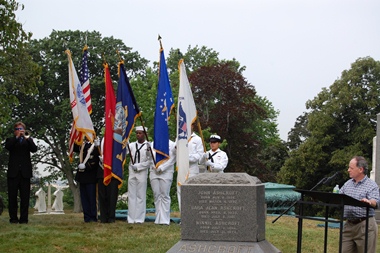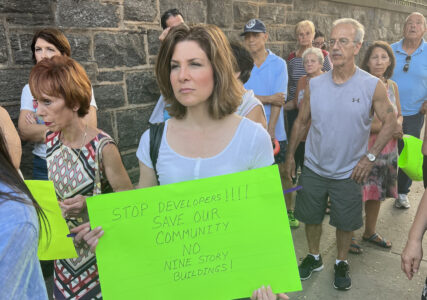One hundred and sixty four years ago a sacrifice was made, and only today is that sacrifice is being acknowledged and honored.
In a solemn ceremony held on Friday, July 13, Green-Wood Cemetery unveiled bronze plaques commemorating five American officers who perished during the Mexican-American War as well as the two men assigned to bring their bodies back for burial. The seven are buried in a joint plot with other casualties of the conflict that, until the cemetery’s leadership stepped in, was marked only by a granite monument carved with the word “Mexico.”
Green-Wood officials decided to create the individual plaques after cemetery historian, Jeff Richman, discovered the plot, and began, “researching this and learning the story of the men who were buried here,” he explained.
There were 800 volunteer soldiers from New York who headed west to fight in the conflict. Those who died, Richman explained, were buried where they fell, so the Common Council, a predecessor to today’s City Council, sent Lieutenant Alexander Forbes to retrieve the bodies. He located them, dug them up, and placed them in their lead coffins to bring them back to New York.
Forbes didn’t make it, however, Richman said. He fell sick and died in New Orleans. Robert Floyd was then sent to complete the mission, returning on July 4, 1848, with the bodies of six men.
Tribute was paid to them, with full military honors and a procession that led eventually to Green-wood where the men were interred. However, the monument that was supposed to be erected to commemorate them was never built, and the graves were marked only with wooden plaques, Richman said.
That was remedied this year, with the Veteran’s Administration footing the bill for the soldiers’ plaques and the Green-Wood Historic Fund picking up the tab for plaques for the two men who were entrusted with bringing the soldiers’ remains home.
“We were honored to be able to place bronzes on the graves of each of these men who served their country, several of whom made the ultimate sacrifice. These were men who were honored greatly by New York City in 1848 and then unfortunately were forgotten for a very, very long time.” said Richman.
Among those in the crowd was Bill Asley, the great-great grandchild of Private John Asley, who fought in the Mexican-American War. Asley had begun beating the drum on the issue back in 2007, and was happy to see the belated recognition bestowed.
However, Asley said, he would like to see the monument that was never completed finally finished. “The council in 1848 left half the work for you people today so maybe you can finish the job for them because it’s the city’s responsibility,” he noted.
Another attendee was architect Julie Hanselmann, who is fascinated by cemetery design and funeral customs. “This is my hobby but this is important,” she remarked. “I’m really glad all these people came out.”

 Not in our backyard! Dyker rallies to prevent ‘out of character’ nine-story building from being built
Not in our backyard! Dyker rallies to prevent ‘out of character’ nine-story building from being built  Housing going up at Angel Guardian Home site: School also slated to be built at location
Housing going up at Angel Guardian Home site: School also slated to be built at location